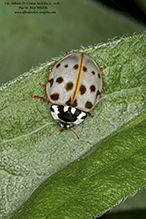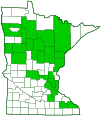fifteen-spotted lady beetle
(Anatis labiculata)
Conservation • Description • Habitat • Ecology • Distribution • Taxonomy
|
|
||||||||||||||
Description |
Fifteen-spotted lady beetle is a native, large, “giant lady beetle.” It occurs in North America east of the Great Plains. It is most common in the United States from Maine to Minnesota in the north to Virginia and Missouri in the south, with just a few scattered records in the west. The body is almost round, very convex, ¼″ to ⅜″ (7.2 to 9.5 mm) long, and 3 ⁄16″ to 5 ⁄16″ (5.5 to 8.0 mm) wide. The head is shallowly inserted into the thorax, but is visible from above. The upper thoracic plate (pronotum) is convex and wider than long. It is white with a large black spot in the center and a small black spot on each lateral margin. The central black spot has two white spots at the base and looks vaguely like a W or M, depending on if it is viewed from the front (W) or from behind (M). The thick, hardened, shell-like forewings (elytra) are strongly convex and very narrowly flattened at the margins. They completely cover the abdomen. The background color is variable but the pattern is not. They may be gray, yellowish-orange, or dark brownish-red, but they always have fifteen black spots. Each elytron has eight spots in a 2-3-3 pattern. The spot in the middle at the base merges with one on the opposite elytron and is counted as a single spot, giving a total count of fifteen. The spots are never ringed with white or yellow. As the beetle ages, the elytra become darker. Older individuals are very dark reddish-brown to almost black, making the spot pattern difficult to see. The legs are yellowish-brown. The fourth segment (tibia) on the middle and hind legs have two spurs at the tip. The last part of each leg (tarsus), corresponding to the foot, has four segments, but the third segment is very short and tucked within the extended lobes of the second segment, making the leg appear to have only three segments. The tip of the last tarsal segment on the middle and hind legs has a pair of claws. Each claw has a large tooth at the base. |
Size |
Total length: ¼″ to ⅜″ (7.2 to 9.5 mm) |
Similar Species |
Habitat |
Forests and woodlands |
Ecology |
Season |
April to July |
Behavior |
|
Life Cycle |
|
Larva Food |
|
Adult Food |
Aphids on coniferous and deciduous trees |
Distribution |
||
|
Sources |
|
| 9/24/2024 | ||
Occurrence |
||
|
||
Taxonomy |
|
Order |
Coleoptera (Beetles) |
Suborder |
Polyphaga (Water, Rove, Scarab, Long-horned, Leaf, and Snout Beetles) |
Infraorder |
Cucujiformia |
Superfamily |
Coccinelloidea (lady, fungus, scavenger, and bark beetles) |
Family |
|
Subfamily |
Coccinellinae (common lady beetles) |
Tribe |
Coccinellini (black-spotted lady beetles) |
Genus |
|
Subordinate Taxa |
|
|
|
Synonyms |
|
Anatis quindecimpunctata |
|
Common Names |
|
fifteen-spotted lady beetle fifteen-spotted ladybird beetle |
|
Glossary
Elytra
The hardened or leathery forewings of beetles used to protect the fragile hindwings, which are used for flying. Singular: elytron.
Pronotum
The exoskeletal plate on the upper side of the first segment of the thorax of an insect.
Tarsus
On insects, the last two to five subdivisions of the leg, attached to the tibia; the foot. On spiders, the last segment of the leg. Plural: tarsi.
Tibia
The fourth segment of an insect leg, after the femur and before the tarsus (foot). The fifth segment of a spider leg or palp. Plural: tibiae.
Visitor Photos |
||
Share your photo of this insect. |
||
This button not working for you? |
||
Alfredo Colon |
||
 |
 |
|
|
||
 |
 |
|
MinnesotaSeasons.com Photos |
||
|
||
|
||

Slideshows |
|

Visitor Videos |
||
Share your video of this insect. |
||
This button not working for you? |
||
|
Other Videos |
||
Fifteen-spotted Lady Beetle (Coccinellidae: Anatis labiculata) Close-up |
About
Published on Jun 24, 2010 This specimen has emerged from the pupa stage within the last day, and is nestled here against the carcass of a dead Tent Caterpillar (Lasiocampidae). Photographed at Turtle River State Park, North Dakota (24 June 2010). |
Fifteen-spotted Lady Beetle (Coccinellidae: Anatis labiculata) on the Move |
About
Published on Jun 6, 2011 Photographed at Turtle River State Park, North Dakota (06 June 2011). |
Fifteen-spotted Lady Beetle (Coccinellidae: Anatis labiculata) |
About
Published on Jun 12, 2010 I understand that the elytra darken with age, and so this must be a very aged specimen. Photographed at Turtle River State Park, North Dakota (11 June 2010). |

Visitor Sightings |
||
Report a sighting of this insect. |
||
This button not working for you? |
||
Alfredo Colon |
Location: Albany, NY |
 |
Lori Ladd |
Location: Cushing, MN |
|
| Technicality Cali 6/30/2022 |
Location: Shafer, MN It should've either went into the neighbors house or better yet should've stayed outside... |
|
| Alfredo Colon 8/20/2018 |
Location: Woodbury, Minnesota |
 |
MinnesotaSeasons.com Sightings |
||

Created: 6/10/2019 Last Updated: © MinnesotaSeasons.com. All rights reserved. |
